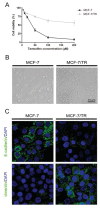Resveratrol sensitizes tamoxifen in antiestrogen-resistant breast cancer cells with epithelial-mesenchymal transition features
- PMID: 23896596
- PMCID: PMC3759878
- DOI: 10.3390/ijms140815655
Resveratrol sensitizes tamoxifen in antiestrogen-resistant breast cancer cells with epithelial-mesenchymal transition features
Abstract
Tamoxifen resistance remains to be a huge obstacle in the treatment of hormone-dependent breast cancer, and this therefore highlights the dire need to explore the underlying mechanisms. The epithelial-mesenchymal transition (EMT) is a molecular process through which an epithelial cell transfers into a mesenchymal phenotype. Roles of EMT in embryo development, cancer invasion and metastasis have been extensively reported. Herein, we established tamoxifen-resistant MCF-7/TR breast cancer cells and showed that MCF-7/TR cells underwent EMT driven by enhanced endogenous TGF-β/Smad signaling. Ectopic supplement of TGF-β promoted in MCF-7 cells a mesenchymal and resistant phenotype. In parallel, we demonstrated that resveratrol was capable of synergizing with tamoxifen and triggering apoptosis in MCF-7/TR cells. Further Western blot analysis indicated that the chemosensitizing effects of resveratrol were conferred with its modulation on endogenous TGF-β production and Smad phosphorylation. In particular, 50 μM resveratrol had minor effects on MCF-7/TR cell proliferation, but could significantly attenuate endogenous TGF-β production and the Smad pathway, ultimately leading to reversion of EMT. Collectively, our study highlighted distinct roles of EMT in tamoxifen resistance and resveratrol as a potential agent to overcome acquired tamoxifen resistance. The molecular mechanism of resveratrol chemosensitizing effects is, at least in part, TGF-β/Smad-dependent.
Figures






Similar articles
-
Resveratrol suppresses epithelial-to-mesenchymal transition in colorectal cancer through TGF-β1/Smads signaling pathway mediated Snail/E-cadherin expression.BMC Cancer. 2015 Mar 5;15:97. doi: 10.1186/s12885-015-1119-y. BMC Cancer. 2015. PMID: 25884904 Free PMC article.
-
MCAM/CD146 promotes tamoxifen resistance in breast cancer cells through induction of epithelial-mesenchymal transition, decreased ERα expression and AKT activation.Cancer Lett. 2017 Feb 1;386:65-76. doi: 10.1016/j.canlet.2016.11.004. Epub 2016 Nov 9. Cancer Lett. 2017. PMID: 27838413
-
Acquisition of epithelial-mesenchymal transition phenotype in the tamoxifen-resistant breast cancer cell: a new role for G protein-coupled estrogen receptor in mediating tamoxifen resistance through cancer-associated fibroblast-derived fibronectin and β1-integrin signaling pathway in tumor cells.Breast Cancer Res. 2015 May 21;17(1):69. doi: 10.1186/s13058-015-0579-y. Breast Cancer Res. 2015. PMID: 25990368 Free PMC article.
-
Mechanisms associated with resistance to tamoxifen in estrogen receptor-positive breast cancer (review).Oncol Rep. 2014 Jul;32(1):3-15. doi: 10.3892/or.2014.3190. Epub 2014 May 16. Oncol Rep. 2014. PMID: 24841429 Review.
-
Role of TGF-β signaling in the mechanisms of tamoxifen resistance.Cytokine Growth Factor Rev. 2021 Dec;62:62-69. doi: 10.1016/j.cytogfr.2021.09.005. Epub 2021 Sep 26. Cytokine Growth Factor Rev. 2021. PMID: 34635390 Review.
Cited by
-
Resveratrol enhances the sensitivity of FL118 in triple-negative breast cancer cell lines via suppressing epithelial to mesenchymal transition.Mol Biol Rep. 2021 Jan;48(1):475-489. doi: 10.1007/s11033-020-06078-y. Epub 2021 Jan 3. Mol Biol Rep. 2021. PMID: 33389483
-
Targeting extracellular matrix remodeling in disease: Could resveratrol be a potential candidate?Exp Biol Med (Maywood). 2017 Feb;242(4):374-383. doi: 10.1177/1535370216675065. Epub 2016 Oct 23. Exp Biol Med (Maywood). 2017. PMID: 27798117 Free PMC article. Review.
-
A Systematic Review of the Potential Chemoprotective Effects of Resveratrol on Doxorubicin-Induced Cardiotoxicity: Focus on the Antioxidant, Antiapoptotic, and Anti-Inflammatory Activities.Oxid Med Cell Longev. 2021 Aug 22;2021:2951697. doi: 10.1155/2021/2951697. eCollection 2021. Oxid Med Cell Longev. 2021. PMID: 34471463 Free PMC article.
-
Tamoxifen reverses epithelial-mesenchymal transition by demethylating miR-200c in triple-negative breast cancer cells.BMC Cancer. 2017 Jul 19;17(1):492. doi: 10.1186/s12885-017-3457-4. BMC Cancer. 2017. PMID: 28724364 Free PMC article.
-
Evaluation of Drug Resistance in the Tamoxifen-treated MKN-45 Gastric Cancer Cell Line via the Epithelial-mesenchymal Transition Signaling Pathway.Int J Mol Cell Med. 2023;12(4):361-371. doi: 10.22088/IJMCM.BUMS.12.4.361. Int J Mol Cell Med. 2023. PMID: 39006197 Free PMC article.
References
-
- Jemal A., Siegel R., Ward E., Hao Y., Xu J., Thun M.J. Cancer statistics, 2009. CA Cancer J. Clin. 2009;59:225–249. - PubMed
-
- Miller W.R., Bartlett J.M., Canney P., Verrill M. Hormonal therapy for postmenopausal breast cancer: The science of sequencing. Breast Cancer Res. Treat. 2007;103:149–160. - PubMed
-
- Perey L., Paridaens R., Hawle H., Zaman K., Nolé F., Wildiers H., Fiche M., Dietrich D., Clément P., Köberle D., et al. Clinical benefit of fulvestrant in postmenopausal women with advanced breast cancer and primary or acquired resistance to aromatase inhibitors: Final results of phase II Swiss Group for Clinical Cancer Research Trial (SAKK 21/00) Ann. Oncol. 2007;18:64–69. - PubMed
-
- Gutierrez M.C., Detre S., Johnston S., Mohsin S.K., Shou J., Allred D.C., Schiff R., Osborne C.K., Dowsett M. Molecular changes in tamoxifen-resistant breast cancer: Relationship between estrogen receptor, HER-2, and p38 mitogen-activated protein kinase. J. Clin. Oncol. 2005;23:2469–2476. - PubMed
-
- Holm C., Rayala S., Jirström K., Stål O., Kumar R., Landberg G. Association between Pak1 expression and subcellular localization and tamoxifen resistance in breast cancer patients. J. Natl. Cancer Inst. 2006;98:671–680. - PubMed
Publication types
MeSH terms
Substances
LinkOut - more resources
Full Text Sources
Other Literature Sources

